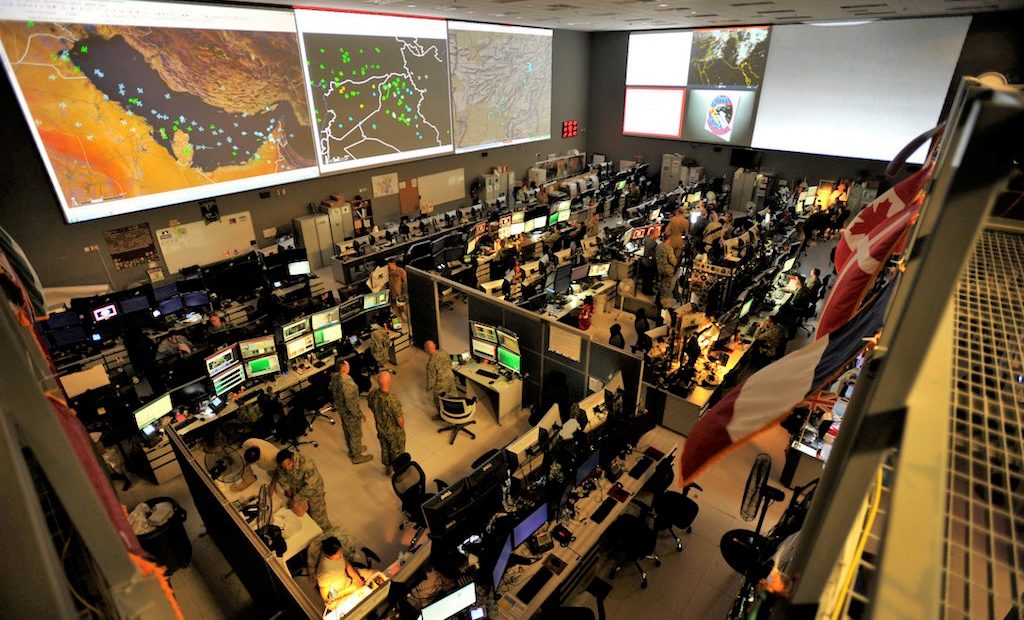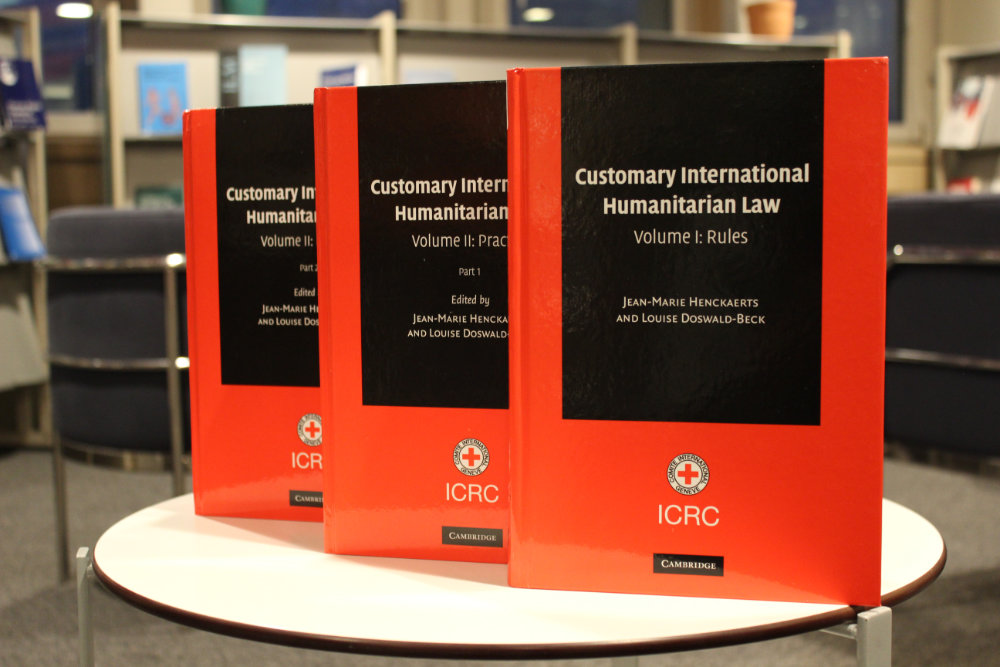From military justice and legal reviews of new weapons technologies to advising on combat operations and law of war training, legal advisers have for some time performed a wide variety of tasks for State militaries. In recent decades, however, legal advisers (or military lawyers, as they are sometimes also called) have taken on a more prominent role in aerial targeting operations, including those in urban warfare settings. Urban warfare poses heightened risk for both combatants and civilians, and military lawyers have been tasked with the difficult job of advising commanders on the legal intricacies of aerial targeting operations that can and do have a significant impact on cities and their populations.
I spent much of the last decade researching urban warfare in the Middle East and my new book ‘The War Lawyers: The United States, Israel and Juridical Warfare’ describes and explains the extensive and often underappreciated role that legal advisers now play in the various stages of aerial targeting operations.
A specific requirement to provide military commanders with legal advisers was first introduced in Article 82 of Additional Protocol I with a view to helping ensure that decisions taken by commanders are in conformity with IHL and that appropriate instruction is provided to armed forces. Interestingly, Article 82 noted that Parties to the conflict ‘shall ensure that legal advisers are available, when necessary, to advise military commanders at the appropriate level on the application of the Conventions and this Protocol […]’, but it did not define ‘necessary’ or ‘appropriate’. According to the ICRC, State practice and opinio juris establishes this rule as a norm of customary international law for State armed forces.
The nature and extent of involvement by legal advisers in aerial targeting operations today varies from State to State. The United States pioneered their use in aerial targeting operations during the First Gulf War in 1991, and military lawyers systematically reviewed information about targets that would be struck from the air, many of them in Baghdad.[1] Since these early experiments in self-regulation many other nations, including Israel, the U.K., Australia, Canada, France, and the Netherlands – and many others – now regularly consult legal experts before, during, and after launching military strikes. Although individual States may have varied understandings of their own obligations vis-à-vis what constitutes ‘necessary’ and ‘appropriate’ use of legal advisers, it is becoming increasingly common to integrate them into not only aerial targeting but also land, sea, and cyber targeting operations as well.
Lawyers in the loop?
But what role do legal advisers play, and what does it mean to have a lawyer ‘in the loop’? To answer this question, it is helpful to differentiate between two broad types of aerial targeting, the first of which is typically called ‘deliberate’ (planned) and the second ‘dynamic’ or ‘time-sensitive’ (unplanned or unanticipated targets of opportunity and/or “troops in contact” scenarios). The main difference here concerns the availability of time and urgency of the operation. Deliberate targeting tends to be scheduled and planned over a longer period (e.g., weeks or months), whereas dynamic targeting responds to events in real-time and therefore the process can take place relatively quickly (e.g., minutes or hours).
Legal advisers are often involved in both types of targeting, but while their role in the deliberate targeting process is often extensive and highly routine, their role in dynamic targeting can be more limited and ad hoc. There are several reasons why roles vary, but two important explanations are, first, that legal advisers are not always available at the tactical and forward levels of command and, second, even when they are available, operational constraints, including the potential need to act immediately, mean that it is not always possible, or practical to seek legal advice. Such is the nature of much urban warfare today, and because cities are brimming with spontaneous activities of everyday life, it can be difficult to plan some types of targeting operations far in advance. For this reason, many if not most aerial targeting operations in cities today have a strong dynamic component that makes lengthy legal deliberation difficult and more time-constrained – though deliberate targeting of fixed military installations also remains a key feature of urban operations.
When legal advisers are ‘in the loop’ in both deliberate and dynamic aerial targeting or other military operations, they offer legal advice to commanders and soldiers on key legal principles such as military necessity and distinction (e.g. can the commander positively identify the military nature of the target?), proportionality (e.g. if the strike goes ahead how can we be assured that expected incidental harm to civilians and civilian objects will not be excessive in relation to the concrete and direct military advantage anticipated?) and precautions (e.g. what can be done to avoid or at least minimize harm to non-combatants and civilian infrastructure, including in the choice of means and methods of warfare?).
What all of this looks like in practice is specific to each State and each theatre of military operation, but legal advisers often have access to classified materials and when time permits, they may review intelligence on specific targets, recommend certain precautions be taken, monitor communications, and involve themselves in the daily operational rhythms of aerial targeting. A legal adviser’s involvement can be prolonged and extensive (e.g., multiple, and ongoing reviews of some targets, in particular for deliberate targeting) or it can be very brief (e.g., a quick exchange of words or a couple sentences of legal advice in particular for dynamic targeting), though there may be situations where they are not directly involved. Legal advice and legal considerations, however, shape modern aerial targeting operations even when legal advisers are not directly ‘in the loop’, because many State militaries have internalized legal principles and integrated them into the very machinery of targeting, including via instruction and training provided by military lawyers to combatants.
The power of the legal word
As their job title suggests, the role of a legal adviser is to advise. They are tasked with providing advice to commanders on their responsibilities as well as their rights under domestic and international law. Formally speaking, legal advisers are not decision makers: their job is to advise, while it remains the long-held responsibility of military commanders to decide, for example, whether or not a strike goes ahead. In reality, however, responsibility is often shared because legal advice carries a special sort of weight and can be viewed by commanders as determinative of how (and even whether) to proceed with a military action.
One military lawyer recently described his legal advice as becoming imbued with a ‘mysterious legal aura’ that has the potential to cause commanders to hesitate or to depart from their intuition. In this particular case, three words were all that were needed to give the final green light on an aerial strike: ‘No legal objection’. That the legal word has a special power when it comes to aerial targeting operations is perhaps not surprising and parallels other socio-legal studies that have found that law and legal systems generate their own legitimacy and structure power relations across society, economy and ideology.
Time and again my research found that commanders look to legal advisers not only and straightforwardly for legal advice, but also sometimes for something approximating permission, and even for psychological and moral support. One military lawyer told me that he sometimes feels more like a chaplain than a legal adviser because commanders came to him ‘looking more for absolution than for legal advice a lot of times’.[2] Another explained that legal advice helps to reassure commanders that they are doing the ‘right thing’ and singled it out as having an important psychological impact for combatants who are involved in life and death decisions.[3]
Of course, just because something is legal does not make it right, and whether or not there is a tendency to conflate law and morality among legal advisers and military decision makers is beyond the scope of this post. But all this nevertheless suggests that legal advisers play an increasingly important role in aerial warfare. When legal advisers provide advice to commanders, they shape military operations in crucial and underappreciated ways. Indeed, they are perhaps the most important conduit for the operationalization of the principles and rules of IHL and, through their daily work, they interpret rights and obligations and render the written word of law into material realities on the ground. In short, legal advice matters.
If legal advice matters then so too does its form, content, and style. In The War Lawyers, I argue that when legal advisers ‘apply’ IHL they are also actively interpreting it as they weigh up what they understand to be their nation’s responsibilities and rights. In a perfect world, IHL serves as a baseline set of standards incorporating important principles from military necessity and the combatant’s privilege to humanity. Often, States impose limits to conduct that are in excess of what IHL demands, for example for political, diplomatic, military, or ethical reasons. But other times, States undermine IHL either by violating it or by advancing legal positions or establishing practices that run counter to the object and purpose of rules that seek to protect civilians and other protected groups. Legal advice can fall into both camps, and my research has shown that military lawyers can act both to constrain as well as enable military violence. Although great efforts have been made by some State militaries to minimize civilian casualties, it is wrong to assume that all legal advisers whether involved directly or indirectly in aerial targeting operations are interpreting and applying IHL in a manner that is more protective for civilians.
Urban warfare and ramifications for civilians
Legal principles can be difficult to apply in the classroom, let alone during the heat of battle, but in recent decades State militaries have increasingly put legal interpretation to work in a particularly opaque and complex space: the city.
Urban warfare is not a new phenomenon, and the city is no stranger to the ravages of war, but in the last 20-30 years the city has reasserted itself as a key battleground: think Sarajevo, Grozny, Baghdad, Beirut, Gaza City, Tskhinvali, Gori, Aleppo, Taiz, Homs, Eastern Ghouta, Fallujah, Mosul, and Sana’a . . . the list goes on. Telling friend from foe is always a fraught affair, whether from ground, sea, or air, but at the moment fighting enters the city – a space full of civilians and civilian objects – it becomes even more difficult.
There have been two broad responses to what social theorist Stephen Graham has called the ‘urbanization of warfare’.[4] The first has been to largely ignore the civilian geographies of the city and to bombard it more or less indiscriminately as though everyone and everything were a military target. In many ways this is a continuation of mid-twentieth century urban warfare, where little attempt was made to distinguish civilians from combatants and entire cities became blazing infernos later reduced to rubble: London and Coventry, but also Berlin, Hamburg, Dresden, Yokohama, Toyama, Tokyo . . . again, the list goes on.
The second strategy has seen a serious attempt to cut through the proverbial ‘fog of war’ with a suite of cutting-edge technologies, techniques, and strategies in order to minimize harm to civilians and civilian casualties. This latter approach relies heavily and increasingly on legal adjudication and the close involvement of legal advisers in all stages of targeting processes. While this approach represents decades of efforts by State and non-State armed forces (with no small amount of advocacy from the humanitarian community) even this more measured and more legally involved method has and continues to do significant harm to civilian populations.
One of the most vital but not clearly understood reasons why even well-equipped militaries continue to cause harm to civilians is the rapid and rapidly changing pace of both urban life and urban warfare. Over the last 30 years, various State militaries have devoted significant resources toward civilian casualty mitigation in particular towards refining targeting procedures and ‘precision’ in general. These efforts are not designed to be perfect, and they certainly aren’t, but the best practice permitted by careful deliberative targeting processes are frequently cut short when it comes to fast-paced dynamic targeting in dense urban places. In the latter, the decision-making process is extremely compressed and the normal procedures – collateral damage assessments, proportionality analysis – though technically present, are routinely foreshortened. As I noted above, the speed at which decisions must be made weigh heavily on the legal calculations and the (perceived) threat is computed as military necessity because of the potential harm that might be done to troops or friendly forces. Inevitably, when the process is sped up, it increases the chances of things going wrong, be that misidentifying the target or causing more civilian casualties than anticipated. Errors are magnified when local, national or coalition troops on the ground call in aerial fire (‘Close Air Support’) to interdict an enemy post or kill enemies who are firing at them (‘Troops in Contact’). A well-known report by Human Rights Watch several years ago concluded that this latter form of targeting was the most dangerous of all to civilians.
As war moves in and out of cities in the twenty-first century, legal advisers will likely continue to weigh in on the complex and lethal business of aerial targeting. IHL can and will play an important role in protecting civilians and other protected groups during targeting operations in urban areas, and the onus of doing so rests not only on commanders but also on legal advisers. Good faith interpretations of IHL rules on the conduct of hostilities are needed all day, every day if civilians and others are to be spared the worst of urban warfare’s all-too-familiar ravages.
[1] The author’s research suggests that the First Gulf War was the first major war in which military lawyers provided legal advice on aerial targeting, but military lawyers were also employed in a similar capacity during the US military campaign in Panama in 1989. US military lawyers were involved in naval targeting operations earlier on, for example, during the Vietnam War. More research is needed on the historical aspects of when and why other States first employed military lawyers to provide advice on targeting operations.
[2] Quoted in: Craig Jones, The War Lawyers: The United States, Israel and Juridical Warfare (OUP, 2020), P. 309.
[3] Ibid.
[4] For further reading, see Stephen Graham’s book, Cities Under Siege and Martin Coward’s work on the concept of Urbicide.
See also
- Laurent Gisel, Pilar Gimeno Sarciada, Ken Hume & Abby Zeith, Urban warfare: an age-old problem in need of new solutions, April 27, 2021
- Daniel Palmieri, War and the city: a history, April 29, 2021






Excellent research work and quite helpful and informative too for getting further deep inside the subject.